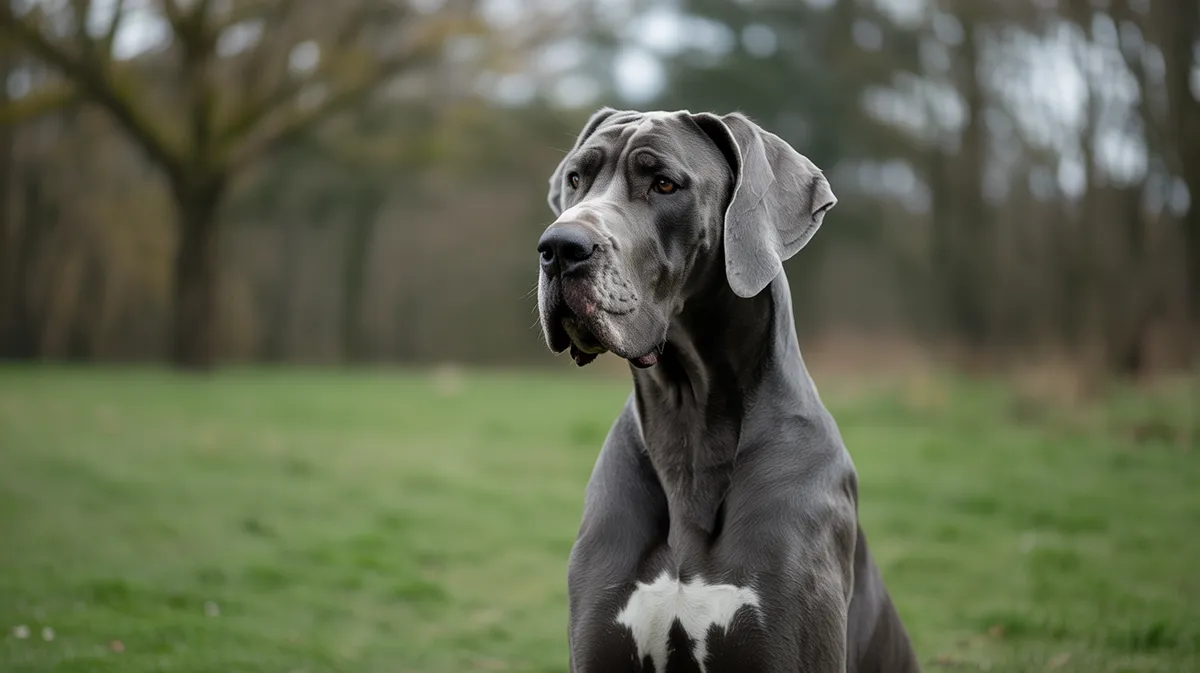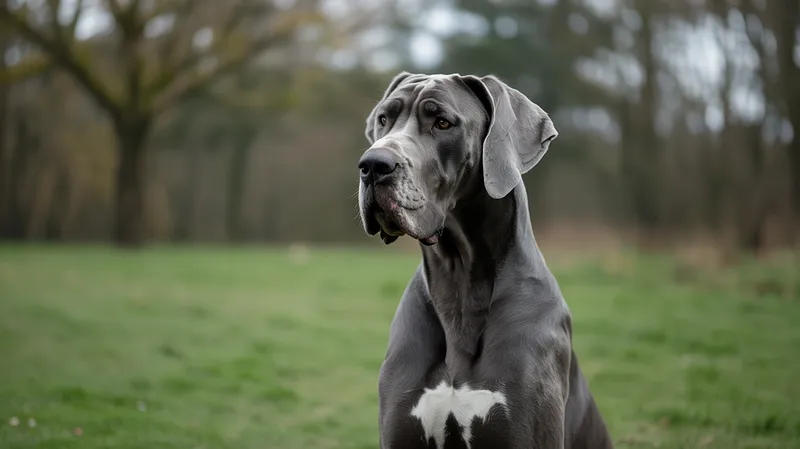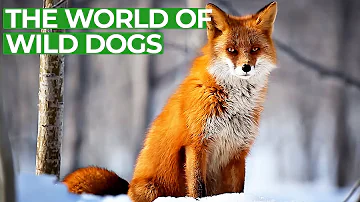
Great Dane
Canis lupus familiaris

Meet the Great Dane
The Great Dane is a giant breed of domestic dog known for its impressive size, elegance, and gentle temperament. Originally bred in Germany for hunting wild boar, these dogs are now celebrated as affectionate family companions and gentle giants. Great Danes possess a muscular build, short coat, and a regal appearance, with males often standing over 32 inches tall at the shoulder. Despite their imposing stature, they are known for their friendly, patient, and loyal nature, making them excellent pets for those with ample space. Their size, however, requires special consideration in terms of care, exercise, and living environment.
Classification
Mammal
Habitat
Domestic
Diet
Omnivore
Lifespan
7-10 years
Conservation
Least Concern
Weight
45-90 kg (100-200 lbs)
📖Fascinating Facts
Impressive Height
Great Danes can easily reach heights over 32 inches at the shoulder, making them one of the tallest dog breeds.
Noble Origins
Originally bred by German nobility, Great Danes were used to hunt wild boar and protect estates.
Gentle Nature
Despite their size, Great Danes are known for being affectionate, patient, and good with children and other pets.
📋Detailed Description
The Great Dane (Canis lupus familiaris) is one of the largest domestic dog breeds, renowned for its towering stature and dignified presence. Adult males typically stand 76–86 cm (30–34 in) at the shoulder and can weigh between 54–90 kg (120–200 lbs), with females slightly smaller. The breed exhibits a powerful, well-muscled body, deep chest, and long, straight limbs, contributing to its athleticism and endurance. The head is rectangular with a pronounced stop, and the ears are naturally floppy, though sometimes cropped in certain countries. The short, dense coat comes in a variety of colors, including fawn, brindle, blue, black, harlequin, and mantle. Great Danes are known for their gentle and affectionate temperament, often described as 'gentle giants.' They are highly social, forming strong bonds with their human families and displaying patience with children and other pets. Despite their size, they are relatively calm indoors but require regular exercise to maintain health. Their lifespan is notably short for a dog, averaging 7–10 years, with some individuals reaching 12 years. Anatomically, their large size predisposes them to certain health challenges, including cardiac issues and orthopedic disorders. Great Danes have a relatively low prey drive compared to other hunting breeds, a trait that has been accentuated through selective breeding for companionship.
💡 Did you know?
A Great Dane named Zeus holds the Guinness World Record for the tallest dog, measuring 44 inches at the shoulder.
🔬Research & Sources
Wikipedia Summary
The Great Dane is a German breed of large mastiff-sighthound, which descends from hunting dogs of the Middle Ages used to hunt bears, wild boar, and deer. They were also used as guardian dogs of German nobility. It is one of the two largest dog breeds in the world, along with the Irish Wolfhound.
Last Modified: 5/5/2025
🎭Behavior & Social Structure
Great Danes are generally calm, affectionate, and loyal, thriving on close human companionship. They display a strong desire to be near their owners, often following them from room to room. Socialization is crucial from an early age to ensure confidence and reduce shyness or fearfulness. While their ancestors were used for hunting large game, modern Great Danes have a low predatory instinct and are rarely aggressive. They are known for their gentle playfulness and tolerance with children, though their size necessitates supervision to prevent accidental injury. Great Danes are moderately active, enjoying daily walks and opportunities to stretch their legs, but they are not hyperactive and often enjoy lounging indoors. They are typically quiet, barking only when necessary, and can serve as effective deterrents due to their imposing appearance. Their feeding behavior is typical of large breeds, requiring two or more small meals per day to reduce the risk of gastric dilatation-volvulus (bloat), a life-threatening condition to which they are predisposed.
👶Reproduction & Life Cycle
Great Danes reach sexual maturity at around 18–24 months, with breeding generally recommended after two years of age to ensure full physical development. The breed has an average estrous cycle of six months, with females coming into heat twice per year. Mating is typically managed by breeders to ensure genetic diversity and minimize hereditary health issues. The gestation period is approximately 63 days. Litter sizes range from 6 to 12 puppies, though larger litters are not uncommon. Neonatal care is intensive due to the puppies' rapid growth and the mother's large size. Parental care is primarily provided by the dam, with weaning beginning at 3–4 weeks of age. Responsible breeders perform health screenings for common genetic disorders, such as hip dysplasia, cardiomyopathy, and certain eye conditions, to promote the health of future generations.
🛡️Adaptations & Survival
The Great Dane's most notable adaptation is its immense size, a result of centuries of selective breeding for hunting large game and serving as a deterrent to intruders. Their long limbs and deep chest provide both speed and stamina, while their powerful jaws and muscular necks were historically advantageous for subduing prey. The breed's short coat is easy to maintain and suited to temperate climates, though they are sensitive to extreme cold and heat due to their low body fat and thin skin. Behaviorally, Great Danes have adapted to domestic life by developing a calm, tolerant demeanor, making them well-suited as companion animals. Their low prey drive and high sociability are the result of selective breeding for temperament over aggression.
📚Research Sources
🎨Cultural Significance
Great Danes have held a prominent place in European culture since the Middle Ages, originally serving as hunting and guard dogs for German nobility. Their imposing stature and noble bearing have made them symbols of strength, loyalty, and protection. The breed is frequently depicted in art and literature, and is well-known in popular culture—perhaps most famously as the inspiration for the cartoon character Scooby-Doo. In some regions, Great Danes are associated with status and prestige, and have been used as mascots for organizations and sports teams. Their gentle nature has also made them popular therapy and service dogs.
🔬Recent Research & Discoveries
Recent research on Great Danes has focused on genetic predispositions to cardiac and orthopedic diseases, with studies identifying specific gene variants linked to dilated cardiomyopathy and hip dysplasia. Advances in veterinary medicine have improved diagnostic and treatment options for these conditions, though prevention through selective breeding remains critical. Ongoing studies are examining the relationship between growth rate, nutrition, and the development of musculoskeletal disorders in giant breeds. There is also active research into the breed's unique temperament, with findings suggesting a strong genetic component to their sociability and low aggression. The Great Dane Genome Project, part of broader canine genomics initiatives, aims to further elucidate the genetic basis of breed-specific traits and health risks.
🎥Wildlife Videos

Wildlife - Just Wild Dogs | Free Documentary Nature
Wildlife - Episode 7: Just Wild Dogs | Wildlife Documentary Watch 'Wildlife - Episode 8' here: https://youtu.be/kglJpB4ei8o Run ...
Free Documentary - Nature

The Greatest Dane of All Never Leaves Your Side | BarkFest
Everything's bigger in Texas...That's certainly the case with Walton, a 10-year-old Great Dane who has been by Judy's side on her ...
Nat Geo Animals

Wildlife - The Fascinating World of Wild Animals | Full Series | Free Documentary Nature
Wildlife - The Fascinating World of Wild Animals | Wildlife Documentary Watch 'Ocean Stories - Full Series' here: ...
Free Documentary - Nature

Tiny Great Danes | Too Cute!
Although they will eventually grow into a great size, these great dane puppies are so tiny at birth that they struggle with every ...
Animal Planet

Charlie & Lindsey, Great Dane.
Charlie & Lindsey, the young once in our pack. Two Great Danes. They are so lovely and beautiful and a great subject for filming.
borninfreedom

Charles' Great Dane | The Incredible Dr. Pol
#NatGeoWILD #GreatDanes #DrPol About The Incredible Dr. Pol: With 100000 patients, Dr. Pol has seen it all. Specializing in ...
Nat Geo Animals
🌍Habitat Information
The Great Dane typically inhabits Domestic environments. Great Danes have adapted to their environments with specialized features and behaviors.
Primary Habitat:
Domestic
More detailed habitat information will be available soon.
🛡️Conservation Status
The Great Dane is currently classified as Least Concern. Conservation efforts are crucial for preserving this species for future generations.
Common Threats:
- 🏠Habitat loss and fragmentation
- 🌡️Climate change impacts
- 🎯Hunting and poaching
- 🏭Human-wildlife conflict
⚠️Threats & Conservation Challenges
The primary threats facing Great Danes are health-related, stemming from their large size and limited genetic pool. They are highly susceptible to gastric dilatation-volvulus (bloat), dilated cardiomyopathy, hip and elbow dysplasia, osteosarcoma (bone cancer), and certain autoimmune disorders. The breed's short lifespan and high incidence of chronic health problems are ongoing challenges for breeders and veterinarians. Overbreeding and irresponsible breeding practices have exacerbated these issues in some populations. While not at risk in terms of conservation status, the breed's welfare depends on rigorous health screening and responsible ownership. Urbanization and limited living space can also pose challenges for prospective owners, as Great Danes require ample room to move and rest comfortably.
🔬Scientific Classification
Scientific Name
Canis lupus familiaris
Classification Hierarchy
🔍 About Taxonomic Classification
Taxonomic classification is a hierarchical system used by scientists to classify and organize living organisms based on shared characteristics and evolutionary relationships.
The system moves from broad categories (Kingdom) to increasingly specific ones, with each animal's scientific name typically consisting of its Genus and species.
📝Community Notes
Share your observations and insights about the Great Dane with our community of wildlife enthusiasts.
Join Our Community
Sign in to share your observations and connect with fellow wildlife enthusiasts.
Sign In to ContributeNo community notes yet
Be the first to share your observations about the Great Dane!
Explore Great Dane
Select a tab above to learn more about this amazing animal.
📸Photo Gallery
No photos available for this animal yet.
🌟Discover More Wildlife
Continue your journey of discovery with more fascinating animals from our database
